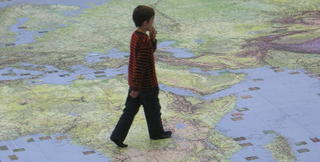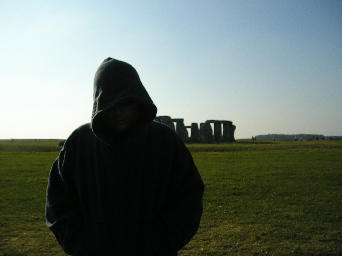Stevenage
On Friday, I visited the Stevenage Museum. Located in the basement of St. Andrew and St. George’s Church (an interesting late 1950s concrete structure), the museum offers free admission to its galleries, which trace the history of the area from the first known Roman settlers in 80 AD through the modern town of today.
Having included in my above description what might be one of my longest, most annoying run-on sentences to date (aside from this one), I have decided to make an attempt, however unsuccessful, to use shorter, more understandable sentences from here on out.
The Stevenage Museum is small (and not as large and well done as the St. Albans Museum) but it does a nice job of showing the town’s history and importance throughout the past two thousand years or so. The museum’s gift counter (it’s not large enough to be considered an full-fledged gift shop) offers several books about Stevenage’s history and the fist Stevenage postcards I’ve seen here. I purchased a few postcards and a small, sixteen-page history of the town (it was well worth the 50p I paid). There is also a small six-page pamphlet available free of charge.
The museum and brochure explain the origin of some of the current place names. For example, Six Hills Way, a major road through town, is named after the Six Hills – six Roman burial mounds dating from 100 AD. In the Old Town of Stevenage, there is a small, narrow passageway called Middle Row. The shops there today have evolved from a live of medieval market stalls. The area of Shephall was once a small village that is now surrounded by Stevenage.
Stevenage is best known today for being the first of New Town, one of eleven proposed satellite towns planned to provide housing for Londoners following the bombings of world War II. Actually, today Stevenage is probably best known for having the highest percentage of teenage pregnancies in England, but in 1946, it was best known as being designated the first New Town. Much of the museum is devoted to items showing how the New Town of Stevenage grew from a small village to the concrete wonderland it is today.
(For those of you who have been to Reston, Virginia, you may understand what I mean when I say that parts of Stevenage remind me of Reston. From what I remember, Reston was a planned town to provide housing for people unable to find it closer to Washington. Since both Reston and Stevenage were both developed at roughly the same time, much of the pre-planned, concrete, urban architecture is similar. And, just as Reston has gotten much larger in the past years, so has Stevenage. However, the central, original areas maintain the 1960s appearance.)
To explain just how important the concept of New Towns were to England, one must to only count the number of Royal visits. In 1956, the Queen Mother laid the foundation stone for St. George’s Church and in 1959, Queen Elizabeth II officially declared the New Town open during her visit to the Town Square, the first pedestrian-only shopping centre in Britain. In 1972, the Queen Mother returned to Stevenage to open the Lister Hospital and in 1995, the Queen opened the GlaxoWellcome Research Centre.
So, to sum things up (or to sum up things if you want to make sure to get the preposition in the proper place), the Stevenage Museum isn’t the greatest museum ever, but it serves to give a very good sense of place for the town throughout history. Plus, you can’t beat the price.
Having included in my above description what might be one of my longest, most annoying run-on sentences to date (aside from this one), I have decided to make an attempt, however unsuccessful, to use shorter, more understandable sentences from here on out.
The Stevenage Museum is small (and not as large and well done as the St. Albans Museum) but it does a nice job of showing the town’s history and importance throughout the past two thousand years or so. The museum’s gift counter (it’s not large enough to be considered an full-fledged gift shop) offers several books about Stevenage’s history and the fist Stevenage postcards I’ve seen here. I purchased a few postcards and a small, sixteen-page history of the town (it was well worth the 50p I paid). There is also a small six-page pamphlet available free of charge.
The museum and brochure explain the origin of some of the current place names. For example, Six Hills Way, a major road through town, is named after the Six Hills – six Roman burial mounds dating from 100 AD. In the Old Town of Stevenage, there is a small, narrow passageway called Middle Row. The shops there today have evolved from a live of medieval market stalls. The area of Shephall was once a small village that is now surrounded by Stevenage.
Stevenage is best known today for being the first of New Town, one of eleven proposed satellite towns planned to provide housing for Londoners following the bombings of world War II. Actually, today Stevenage is probably best known for having the highest percentage of teenage pregnancies in England, but in 1946, it was best known as being designated the first New Town. Much of the museum is devoted to items showing how the New Town of Stevenage grew from a small village to the concrete wonderland it is today.
(For those of you who have been to Reston, Virginia, you may understand what I mean when I say that parts of Stevenage remind me of Reston. From what I remember, Reston was a planned town to provide housing for people unable to find it closer to Washington. Since both Reston and Stevenage were both developed at roughly the same time, much of the pre-planned, concrete, urban architecture is similar. And, just as Reston has gotten much larger in the past years, so has Stevenage. However, the central, original areas maintain the 1960s appearance.)
To explain just how important the concept of New Towns were to England, one must to only count the number of Royal visits. In 1956, the Queen Mother laid the foundation stone for St. George’s Church and in 1959, Queen Elizabeth II officially declared the New Town open during her visit to the Town Square, the first pedestrian-only shopping centre in Britain. In 1972, the Queen Mother returned to Stevenage to open the Lister Hospital and in 1995, the Queen opened the GlaxoWellcome Research Centre.
So, to sum things up (or to sum up things if you want to make sure to get the preposition in the proper place), the Stevenage Museum isn’t the greatest museum ever, but it serves to give a very good sense of place for the town throughout history. Plus, you can’t beat the price.





0 Comments:
Post a Comment
<< Home